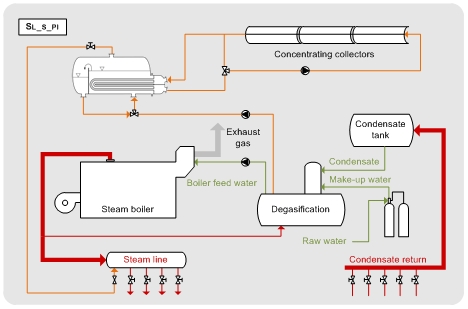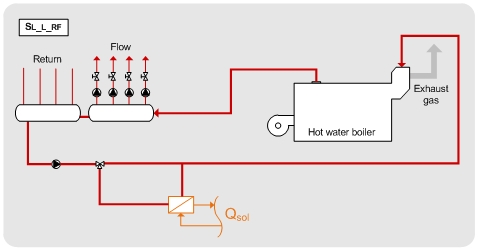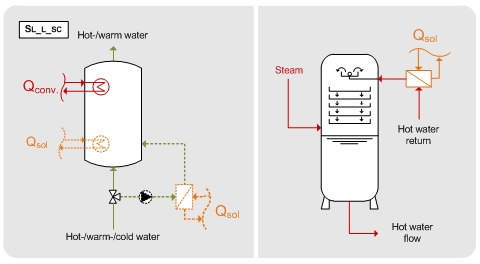Back to EFFICIENCY FINDER
| Most common heat supply technologies in Industry are hot water or steam boilers that supply heat at temperatures up to 250 °C. Based on the respective heat transfer medium (steam or hot water) and irradiation at the company site, different integration concepts for solar heat can be applied.
|

|
SL_S_PD – direct solar steam generation
For the integration concept of direct solar steam generation a steam drum is required that is fed by concentrating collectors. Boiler feed water is fed to the solar heating system and partially evaporated. The water-steam mixture is fed to the steam drum where it is separated. The accumulated water is fed back to the collector loop. In case of sufficient pressure in the steam drum, the steam is fed into the conventional steam circuit.
While solar steam is fed into the existing circuit the conventional steam boiler reduces its steam production similar to operation periods with reduced load. The actual loss of efficiency of the steam boiler caused by the solar heating system is influenced by the ratio of installed solar power to conventional capacity, the typical load, and steam boiler performance (scope of modulation). This integration concept was realized with in several demonstration plants.
|

|
SL_S_PI – indirect solar steam generation
Regarding the interaction of the solar heating system with the conventional steam supply system this integration concept is similar to the prior one (SL_S_PD). For this concept concentrating collectors with pressurized water or thermo oil as heat transfer medium are used to feed a special heat exchanger for evaporation (typically kettle type reboiler). The heat exchanger is operated at the same pressure as the conventional steam system.
|

|
SL_S_FW –solar heating of boiler feed water
The serial integration of solar heat for heating of boiler feed water takes place after degasification. Usually the degasification is operated around 105 °C. The set temperature of boiler feed water depends on the supply pressure of the steam boiler and is usually in the range of 160..220 °C (equals 6 to 23 bar). Typically boiler feed water is (or should be) preheated by an economizer before entering the steam boiler (by approx. 30 K). The remaining temperature difference can be supplied by solar heat. Based on the dimensioning of economizers, a solar preheating of boiler feed water prior to the economizer is not always possible.
|

|
SL_S_MW – solar heating of make-up water
The last integration concept for steam systems is preheating of make-up water which is required to compensate losses of condensate caused by flash evaporation, blow down and direct steam consumption. Make-up water is fed into the degasification after desalting. In principle, the amount of make-up water can be heated by solar energy prior to degasification. However, several waste heat sources within the boiler house can significantly decrease the potential for implementation of solar heat.
|

|
SL_L_P – parallel integration
For the parallel integration of solar heat into hot water circuits, the return is divided prior to the conventional boiler and partially directed through the solar heating system and fed back into the flow. Therefore, the control of the solar heating system has to ensure that the return is heated to the required flow temperature. The integration can be realized directly (SL_L_PD) or indirectly (SL_L_PI). For the direct integration the water of the heating circuit flows directly through the collectors, while a heat exchanger is used for the indirect integration.
|

|
SL_L_RF –solar return flow boost
The serial integration of solar heat is similar to integration concept SL_L_PI, with the difference that the return is preheated. Therefore, no fixed set temperature has to be supplied by the solar heating system. Return line heating might not be desired by the industrial plant operator if the efficiency of the conventional heating system is affected in a negative way (e.g. condensing boiler, CHP or district heating).
|

|
SL_L_SC –solar heating of storages or cascades
There are lots of different types and connection possibilities for hot water storages in industry. There are storages with fixed or variable volume that are fed with hot water or buffer storages that are energetically charged and discharged. Based on the actual number of storages and their configuration solar heat can be used to preheat input streams or to maintain the temperature of the storage. Additionally, hot water cascades can be supplied with solar heat. Usually the hot water return is fed into a cascade and heated up by injection of steam. The integration concept for hot water cascades is similar to SL_L_RF since the return flow is preheated before entering the cascade.
|
| Source: Schmitt, B., 2014. Integration of solar heating plants for supply of process heat in industrial companies (in German language), Dissertation University of Kassel, Shaker Verlag, Aachen, Germany.
|